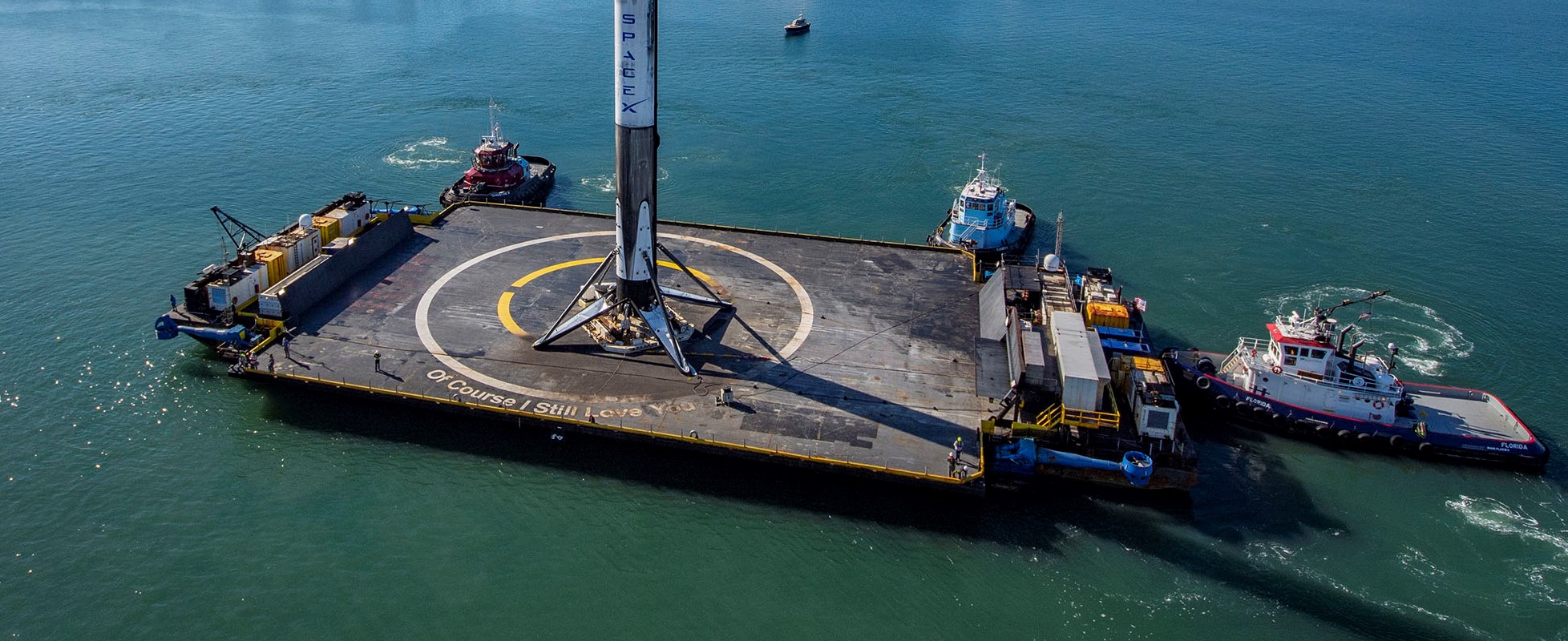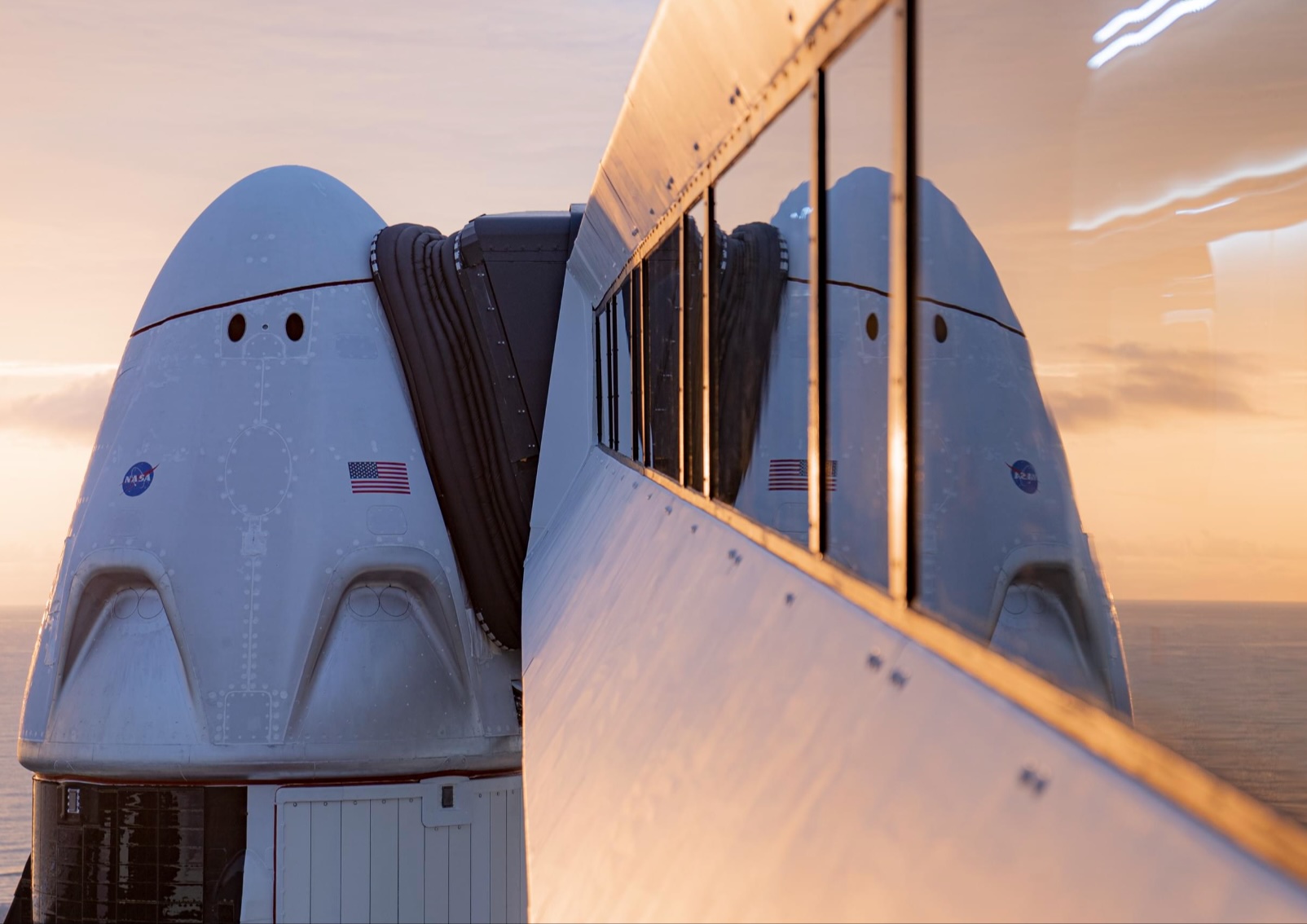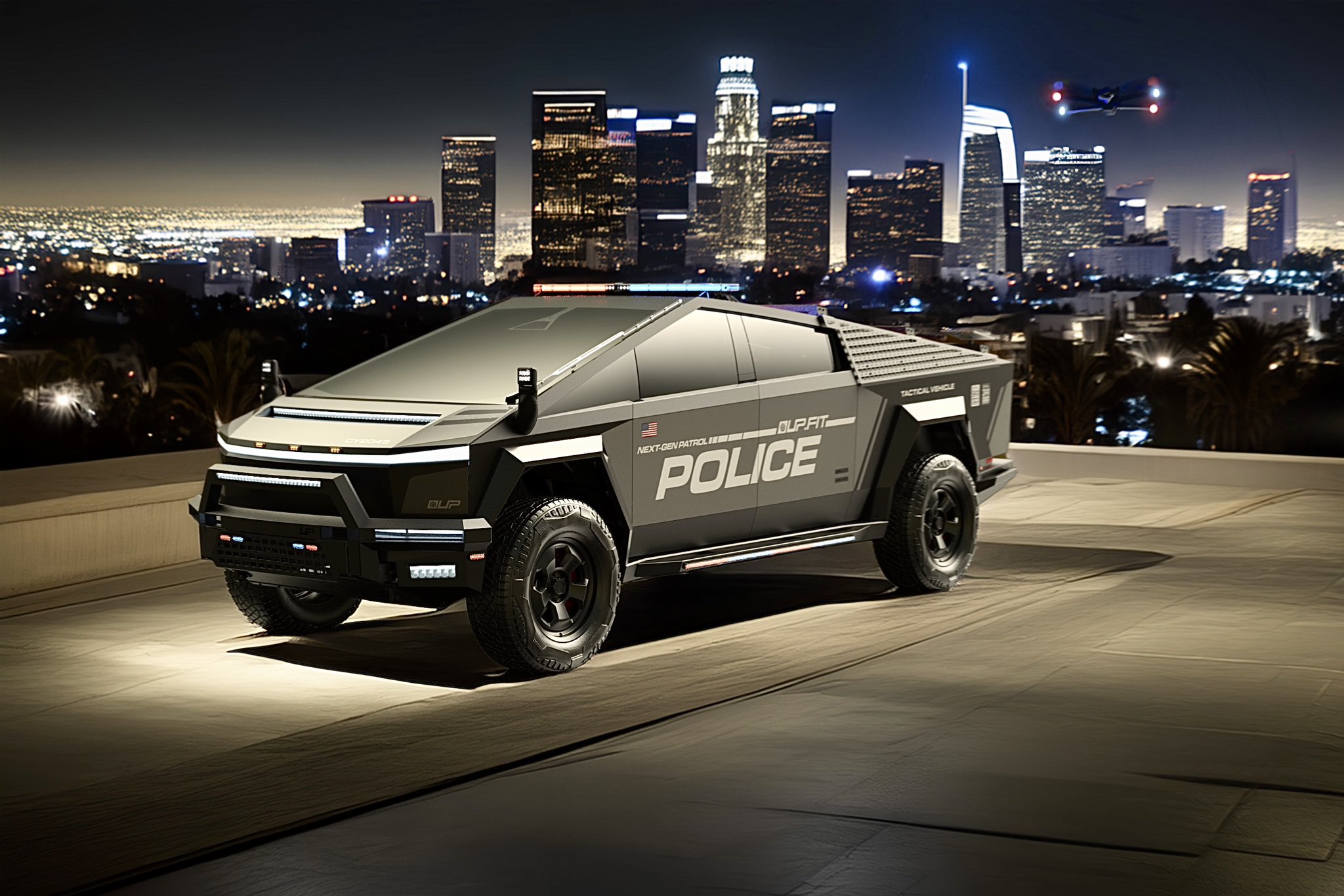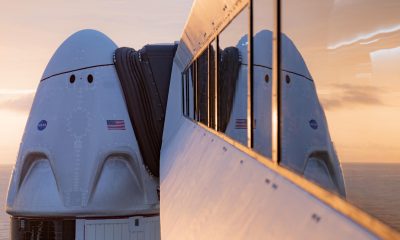

News
SpaceX adds a second drone ship to its East Coast rocket recovery fleet
On December 10th, SpaceX’s East Coast rocket recovery fleet added a second drone ship to its ranks in a bid to expand its capabilities to support dozens of annual Falcon 9 and Heavy launches, as well as experimental Starship and Super Heavy booster recoveries.
Formerly stationed out of Port of Los Angeles to support SpaceX’s once-substantial West Coast launch manifest, the need for West Coast launches has rapidly dried up over the last six months. That drought had such a long lead that SpaceX decided to transfer drone ship Just Read The Instructions (JRTI) through the Panama Canal, moving the vessel several thousand miles from Port of Los Angeles to Port Canaveral, Florida.
JRTI made it through the Canal several months ago and headed East towards Florida before making an intriguing and lengthy pit stop in a Louisiana port. While there, marine engineers and technicians performed a number of unknown tasks presumed to be a scheduled period of inspections and maintenance. In the last few weeks JRTI spent in Louisiana, SpaceX loaded the drone ship with more than a dozen huge generators and power controllers, as well as six massive maneuvering thrusters.
Although perspectives were lacking while JRTI was docked in LA, it was clear that some (or all) of the new hardware was meant for the drone ship, indicating that the rocket recovery platform could be in for some major upgrades. The aforementioned thrusters are much larger and appear to be heavier than JRTI’s former blue azimuth thrusters, four of which also adorn Florida-based drone ship Of Course I Still Love You (OCISLY).
Those massive thrusters are presumably meant for JRTI (and possibly OCISLY). The fact that they have been delivered alongside an even larger number of generators – far more than are usually present on SpaceX drone ships – indicates that their power output is probably larger, too. It’s not clear how much more powerful they are but one goal is unequivocal: with more powerful thrusters, SpaceX’s drone ships should be much more tolerant of bad weather, meaning that SpaceX will be able to launch Falcon 9, Falcon Heavy, and Starship without having to worry as much about the weather hundreds of miles downrange.
Depending on how powerful they are, it’s also possible that those upgraded thrusters are strong enough to independently power drone ships to and from their ocean landing zones. As of now, SpaceX must contract days of tugboat services to tow drone ships to and from their landing zones, by far one of the biggest recurring costs for booster recoveries. If a major power supply upgrade and much larger thrusters are indeed enough to enable independent cruise capabilities, it could significantly streamline SpaceX’s drone ship recovery efforts, cutting costs and increasing flexibility and availability.
It’s hard to say why drone ship JRTI only brought six new thrusters with it, given that SpaceX’s East Coast fleet now has two drone ships and four thrusters are needed to enable stationkeeping on just one of them. Perhaps two more thrusters are on backorder and will be delivered directly to Port Canaveral. More likely, only one drone ship – likely JRTI – will initially be upgraded with new thrusters and power equipment, leaving two spare thrusters in case those installed are damaged by recovery attempts or fail for more mundane reasons.
In the past, drone ship OCISLY has suffered a handful of recovery anomalies that forced SpaceX to replace the vessel’s blue azimuth thrusters and their associated hydraulic equipment. In some cases, a lack of replacement thrusters lead SpaceX to scavenge drone ship JRTI, leaving the ship without thrusters for several months. With these latest upgrades, SpaceX has presumably learned from those past mistakes and ensured that several spare generators and thrusters are on hand.
Given that SpaceX has yet to install those upgraded thrusters or generators on either JRTI or OCISLY, as well as the general uncertainty surrounding their purpose, it’s safe to say that the next several weeks will be exciting. For now, it’s unknown when JRTI will be ready to support its first East Coast rocket recovery, but there will be plenty of launches to choose from once she is.
With two drone ships now stationed out of Port Canaveral, SpaceX will be able to support a more capable Falcon Heavy configuration, expending the center core while recovering both side boosters at sea. SpaceX will also be able to attempt experimental Starship and Super Heavy drone ship landings while still having a spare ship to support its regular Falcon 9 missions. Most importantly, two drone ships will allow SpaceX to reach launch/landing cadences and turnaround times previously impossible with a single ship, an absolute necessity if the company hopes to achieve its goal of ~24 Starlink launches on top of 10+ commercial launches in 2020.
Check out Teslarati’s Marketplace! We offer Tesla accessories, including for the Tesla Cybertruck and Tesla Model 3.
News
SpaceX’s Crew-11 mission targets July 31 launch amid tight ISS schedule
The flight will lift off from Launch Complex 39A at Kennedy Space Center in Florida.

NASA and SpaceX are targeting July 31 for the launch of Crew-11, the next crewed mission to the International Space Station (ISS). The flight will lift off from Launch Complex 39A at Kennedy Space Center in Florida, using the Crew Dragon Endeavour and a Falcon 9 booster.
Crew Dragon Endeavour returns
Crew-11 will be the sixth flight for Endeavour, making it SpaceX’s most experienced crew vehicle to date. According to SpaceX’s director of Dragon mission management, Sarah Walker, Endeavour has already carried 18 astronauts representing eight countries since its first mission with NASA’s Bob Behnken and Doug Hurley in 2020, as noted in an MSN report.
“This Dragon spacecraft has successfully flown 18 crew members representing eight countries to space already, starting with (NASA astronauts) Bob (Behnken) and Doug (Hurley) in 2020, when it returned human spaceflight capabilities to the United States for the first time since the shuttle retired in July of 2011,” Walker said.
For this mission, Endeavour will debut SpaceX’s upgraded drogue 3.1 parachutes, designed to further enhance reentry safety. The parachutes are part of SpaceX’s ongoing improvements to its human-rated spacecraft, and Crew-11 will serve as their first operational test.
The Falcon 9 booster supporting this launch is core B1094, which has launched in two previous Starlink missions, as well as the private Ax-4 mission on June 25, as noted in a Space.com report.
The four-members of Crew-11 are NASA astronauts Zena Cardman and Mike Fincke, as well as Japan’s Kimiya Yui and Russia’s Oleg Platonov.
Tight launch timing
Crew-11 is slated to arrive at the ISS just as NASA coordinates a sequence of missions, including the departure of Crew-10 and the arrival of SpaceX’s CRS-33 mission. NASA’s Bill Spetch emphasized the need for careful planning amid limited launch resources, noting the importance of maintaining station altitude and resupply cadence.
“Providing multiple methods for us to maintain the station altitude is critically important as we continue to operate and get the most use out of our limited launch resources that we do have. We’re really looking forward to demonstrating that capability with (CRS-33) showing up after we get through the Crew-11 and Crew-10 handover,” Spetch stated.
Lifestyle
EV fans urge Tesla to acquire Unplugged Performance for edge in fleet and security industry
Unplugged Performance has built a name for itself by producing performance upgrades for Tesla vehicles.

A growing number of Tesla enthusiasts and longtime community voices are calling on the electric vehicle maker to acquire Unplugged Performance, a California-based aftermarket company best known for tuning Tesla vehicles and developing specialized government fleet solutions under its UP.FIT division.
The idea was once considered a niche proposal among EV fans, but it is now gaining serious attention not just as a performance play but as a strategic move to deepen Tesla’s roots in the fleet and security industry.
A strategic fit
Unplugged Performance has built a name for itself by producing performance upgrades for Tesla vehicles, from track-optimized components to visual and aerodynamic upgrades. But in recent years, its UP.FIT division has pivoted toward a more functional future by outfitting Tesla vehicles like Model Ys for police, military, and government use.
That work has sparked growing calls for closer collaboration with Tesla, especially as the EV maker increasingly leans into autonomy, AI, and fleet services as core components of its next chapter.
“I posted this four years ago, but I think it’s more true now than ever,” wrote Whole Mars Catalog, a well-known Tesla investor and FSD Beta tester, on X. “Tesla should buy Unplugged. But not just as a Performance division. What they are doing with UP.FIT unlocks large government and commercial fleet purchases that can improve utilization.”
Tesla fans such as shareholder Sawyer Merritt echoed the sentiment, calling Unplugged a “great fit within Tesla.” adding, “They are literally located directly next to Tesla’s design studio in Hawthorne.”
Enabling the next wave
Supporters of the idea noted that integrating Unplugged into Tesla’s corporate structure could help accelerate the adoption of autonomous technologies in government sectors. With UP.FIT patrol cars already in use across some U.S. police departments, Tesla fans envisioned a future where self-driving Teslas could potentially revolutionize law enforcement, search-and-rescue, and public service logistics.
“Just imagine how autonomous patrol cars could transform policing and bring us into a safer future,” the veteran FSD tester wrote.
The benefits could also extend to Tesla’s existing consumer base. “They also have some incredible products in the works that I think will appeal to many ordinary Tesla drivers — not just those looking for performance or mods. Stuff that’s so good it should have come straight from the design studio next door,” Whole Mars Catalog noted.
Unplugged Performance, founded in 2013, shares not just a product vision with Tesla, but also geography. Its Hawthorne headquarters sits directly adjacent to Tesla’s design studio, and the two companies have maintained a close working relationship over the years. The aftermarket firm has long positioned itself as a “mission-aligned” partner to Tesla.
In response to the recent calls for acquisition, Unplugged Performance acknowledged the support from the community. “Our very existence is to support the Tesla mission with @UpfitTesla and @UnpluggedTesla,” Unplugged CEO Ben Schaffer posted on X. “We love working with Tesla and are grateful for the community’s support since 2013!”
News
Tesla debuts hands-free Grok AI with update 2025.26: What you need to know
All new Tesla vehicles delivered on or after July 12, 2025, will include Grok AI out of the box

Tesla has begun rolling out Grok, an in-car conversational AI assistant developed by xAI, to eligible vehicles starting July 12. The feature marks the most direct integration yet between Elon Musk’s artificial intelligence startup and Tesla’s consumer product lineup, offering drivers hands-free access to a chat-style companion while on the road.
Grok comes pre-installed on new vehicles
According to Tesla’s FAQ page for the feature, all new vehicles delivered on or after July 12, 2025, will include Grok AI out of the box. Owners of older vehicles may gain access through an over-the-air update, provided their vehicle meets a few hardware and software requirements.
Specifically, Grok is currently only supported on Tesla models equipped with an AMD infotainment processor and running vehicle software version 2025.26 and higher. Compatible models include the Model S, Model 3, Model X, Model Y, and Cybertruck. A Premium Connectivity subscription or active Wi-Fi connection is also required.
Tesla notes that additional vehicle compatibility may arrive in future software updates.
Grok’s features and limitations for now
Drivers can engage with Grok using the App Launcher or by pressing and holding the voice command button on the steering wheel. Grok is designed to answer questions and hold conversations using natural language, offering responses tailored to its chosen personality—ranging from “Storyteller” to the more eccentric “Unhinged.”
For fun, Tesla posted a demonstration of Grok likely running on “Unhinged” talking about what it would do to Optimus when they are on a date, much to the shock of the humanoid robot’s official social media account.
It should be noted, however, that Grok cannot currently issue commands to the vehicle itself, at least for now. Traditional voice commands for tasks like climate control, navigation, or media remain separate from Grok as of writing.
The feature is being released in Beta and does not require a Grok account or xAI subscription to activate, although that policy may change over time.
Grok privacy and in-car experience
Tesla emphasizes that interactions with Grok are securely processed by xAI and not linked to a user’s Tesla account or vehicle. Conversations remain anonymous unless a user signs into Grok separately to sync their history across devices.
Tesla has also begun promoting Grok directly on its official vehicle webpages, showcasing the feature as part of its in-car experience, further highlighting the company’s increasing focus on AI and infotainment features on its all-electric vehicles.
-

 Elon Musk2 weeks ago
Elon Musk2 weeks agoTesla investors will be shocked by Jim Cramer’s latest assessment
-

 Elon Musk3 days ago
Elon Musk3 days agoxAI launches Grok 4 with new $300/month SuperGrok Heavy subscription
-

 Elon Musk5 days ago
Elon Musk5 days agoElon Musk confirms Grok 4 launch on July 9 with livestream event
-

 News1 week ago
News1 week agoTesla Model 3 ranks as the safest new car in Europe for 2025, per Euro NCAP tests
-

 Elon Musk1 week ago
Elon Musk1 week agoxAI’s Memphis data center receives air permit despite community criticism
-

 News2 weeks ago
News2 weeks agoXiaomi CEO congratulates Tesla on first FSD delivery: “We have to continue learning!”
-

 News2 weeks ago
News2 weeks agoTesla sees explosive sales growth in UK, Spain, and Netherlands in June
-

 Elon Musk2 weeks ago
Elon Musk2 weeks agoTesla scrambles after Musk sidekick exit, CEO takes over sales
















